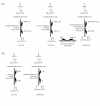The genome sequence of Geobacter metallireducens: features of metabolism, physiology and regulation common and dissimilar to Geobacter sulfurreducens
- PMID: 19473543
- PMCID: PMC2700814
- DOI: 10.1186/1471-2180-9-109
The genome sequence of Geobacter metallireducens: features of metabolism, physiology and regulation common and dissimilar to Geobacter sulfurreducens
Abstract
Background: The genome sequence of Geobacter metallireducens is the second to be completed from the metal-respiring genus Geobacter, and is compared in this report to that of Geobacter sulfurreducens in order to understand their metabolic, physiological and regulatory similarities and differences.
Results: The experimentally observed greater metabolic versatility of G. metallireducens versus G. sulfurreducens is borne out by the presence of more numerous genes for metabolism of organic acids including acetate, propionate, and pyruvate. Although G. metallireducens lacks a dicarboxylic acid transporter, it has acquired a second putative succinate dehydrogenase/fumarate reductase complex, suggesting that respiration of fumarate was important until recently in its evolutionary history. Vestiges of the molybdate (ModE) regulon of G. sulfurreducens can be detected in G. metallireducens, which has lost the global regulatory protein ModE but retained some putative ModE-binding sites and multiplied certain genes of molybdenum cofactor biosynthesis. Several enzymes of amino acid metabolism are of different origin in the two species, but significant patterns of gene organization are conserved. Whereas most Geobacteraceae are predicted to obtain biosynthetic reducing equivalents from electron transfer pathways via a ferredoxin oxidoreductase, G. metallireducens can derive them from the oxidative pentose phosphate pathway. In addition to the evidence of greater metabolic versatility, the G. metallireducens genome is also remarkable for the abundance of multicopy nucleotide sequences found in intergenic regions and even within genes.
Conclusion: The genomic evidence suggests that metabolism, physiology and regulation of gene expression in G. metallireducens may be dramatically different from other Geobacteraceae.
Figures






Similar articles
-
Genome-scale constraint-based modeling of Geobacter metallireducens.BMC Syst Biol. 2009 Jan 28;3:15. doi: 10.1186/1752-0509-3-15. BMC Syst Biol. 2009. PMID: 19175927 Free PMC article.
-
Comparative transcriptomic insights into the mechanisms of electron transfer in Geobacter co-cultures with activated carbon and magnetite.Sci China Life Sci. 2018 Jul;61(7):787-798. doi: 10.1007/s11427-017-9177-1. Epub 2017 Oct 31. Sci China Life Sci. 2018. PMID: 29101585
-
Genetic characterization of a single bifunctional enzyme for fumarate reduction and succinate oxidation in Geobacter sulfurreducens and engineering of fumarate reduction in Geobacter metallireducens.J Bacteriol. 2006 Jan;188(2):450-5. doi: 10.1128/JB.188.2.450-455.2006. J Bacteriol. 2006. PMID: 16385034 Free PMC article.
-
Genome-assisted analysis of dissimilatory metal-reducing bacteria.Curr Opin Biotechnol. 2005 Jun;16(3):269-74. doi: 10.1016/j.copbio.2005.04.001. Curr Opin Biotechnol. 2005. PMID: 15961027 Review.
-
In situ to in silico and back: elucidating the physiology and ecology of Geobacter spp. using genome-scale modelling.Nat Rev Microbiol. 2011 Jan;9(1):39-50. doi: 10.1038/nrmicro2456. Epub 2010 Dec 6. Nat Rev Microbiol. 2011. PMID: 21132020 Review.
Cited by
-
A unique aromatic residue modulates the redox range of a periplasmic multiheme cytochrome from Geobacter metallireducens.J Biol Chem. 2021 Jan-Jun;296:100711. doi: 10.1016/j.jbc.2021.100711. Epub 2021 Apr 26. J Biol Chem. 2021. PMID: 33915126 Free PMC article.
-
Identification and characterization of a succinyl-coenzyme A (CoA):benzoate CoA transferase in Geobacter metallireducens.J Bacteriol. 2012 May;194(10):2501-8. doi: 10.1128/JB.00306-12. Epub 2012 Mar 9. J Bacteriol. 2012. PMID: 22408161 Free PMC article.
-
Electron Transfer between Electrically Conductive Minerals and Quinones.Front Chem. 2017 Jul 13;5:49. doi: 10.3389/fchem.2017.00049. eCollection 2017. Front Chem. 2017. PMID: 28752088 Free PMC article.
-
Genome sequence of Desulfitobacterium hafniense DCB-2, a Gram-positive anaerobe capable of dehalogenation and metal reduction.BMC Microbiol. 2012 Feb 8;12:21. doi: 10.1186/1471-2180-12-21. BMC Microbiol. 2012. PMID: 22316246 Free PMC article.
-
Evidence for a hexaheteromeric methylenetetrahydrofolate reductase in Moorella thermoacetica.J Bacteriol. 2014 Sep;196(18):3303-14. doi: 10.1128/JB.01839-14. Epub 2014 Jul 7. J Bacteriol. 2014. PMID: 25002540 Free PMC article.
References
-
- Lovley DR, Stolz JF, Nord GLJ, Phillips EJP. Anaerobic production of magnetite by a dissimilatory iron-reducing microorganism. Nature. 1987;330:252–254. doi: 10.1038/330252a0. - DOI
-
- Lovley DR, Baedecker MJ, Lonergan DJ, Cozzarelli IM, Phillips EJP, Siegel DI. Oxidation of aromatic contaminants coupled to microbial iron reduction. Nature. 1989;339:297–299. doi: 10.1038/339297a0. - DOI
Publication types
MeSH terms
Substances
LinkOut - more resources
Full Text Sources
Other Literature Sources
Molecular Biology Databases

